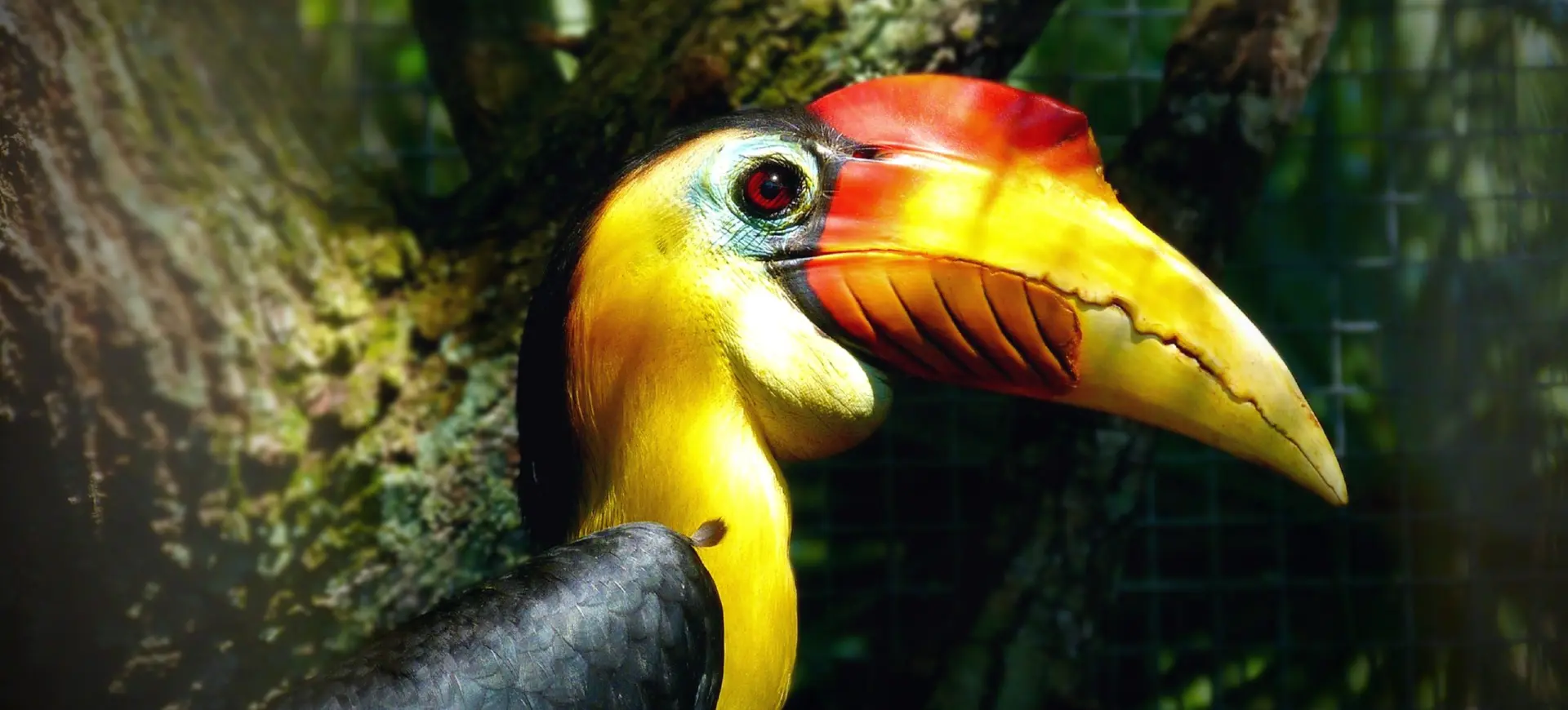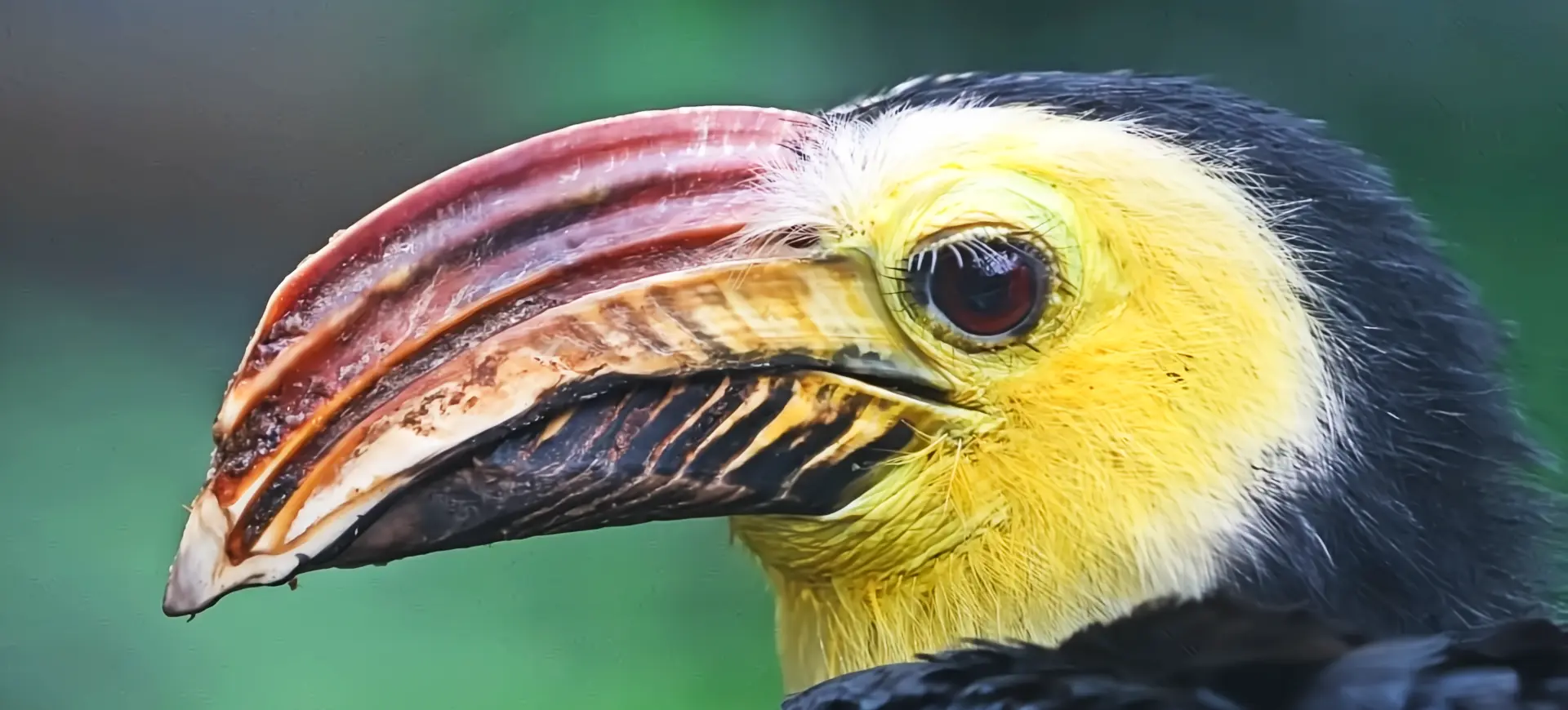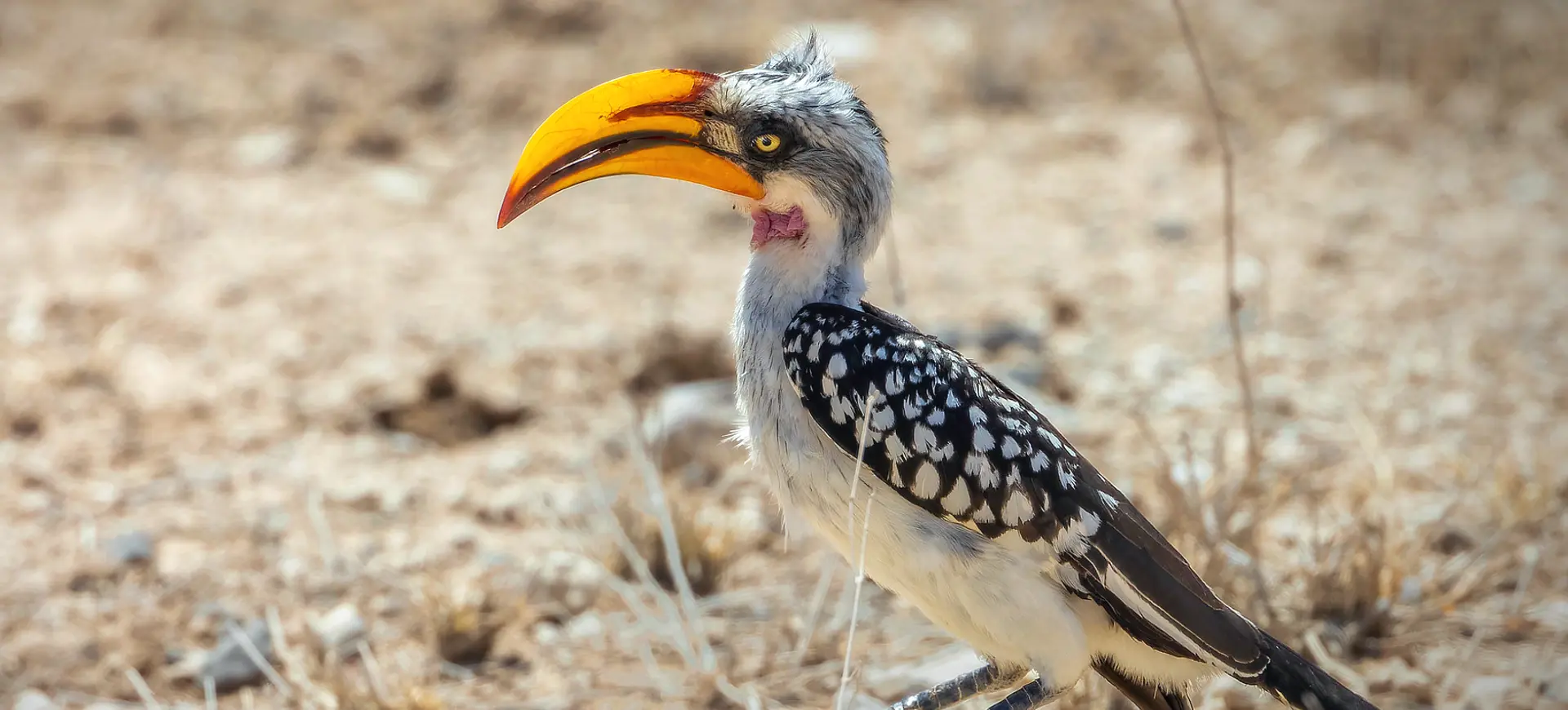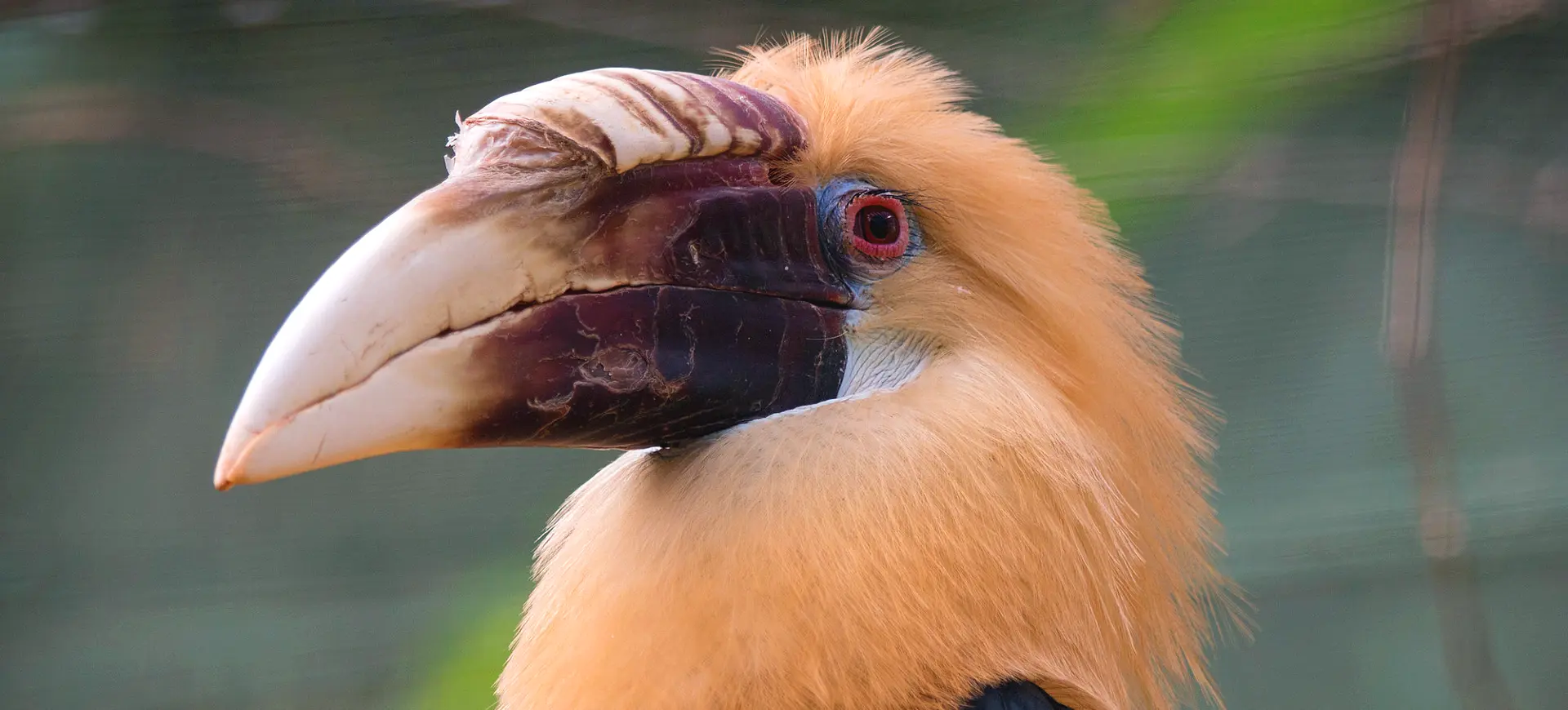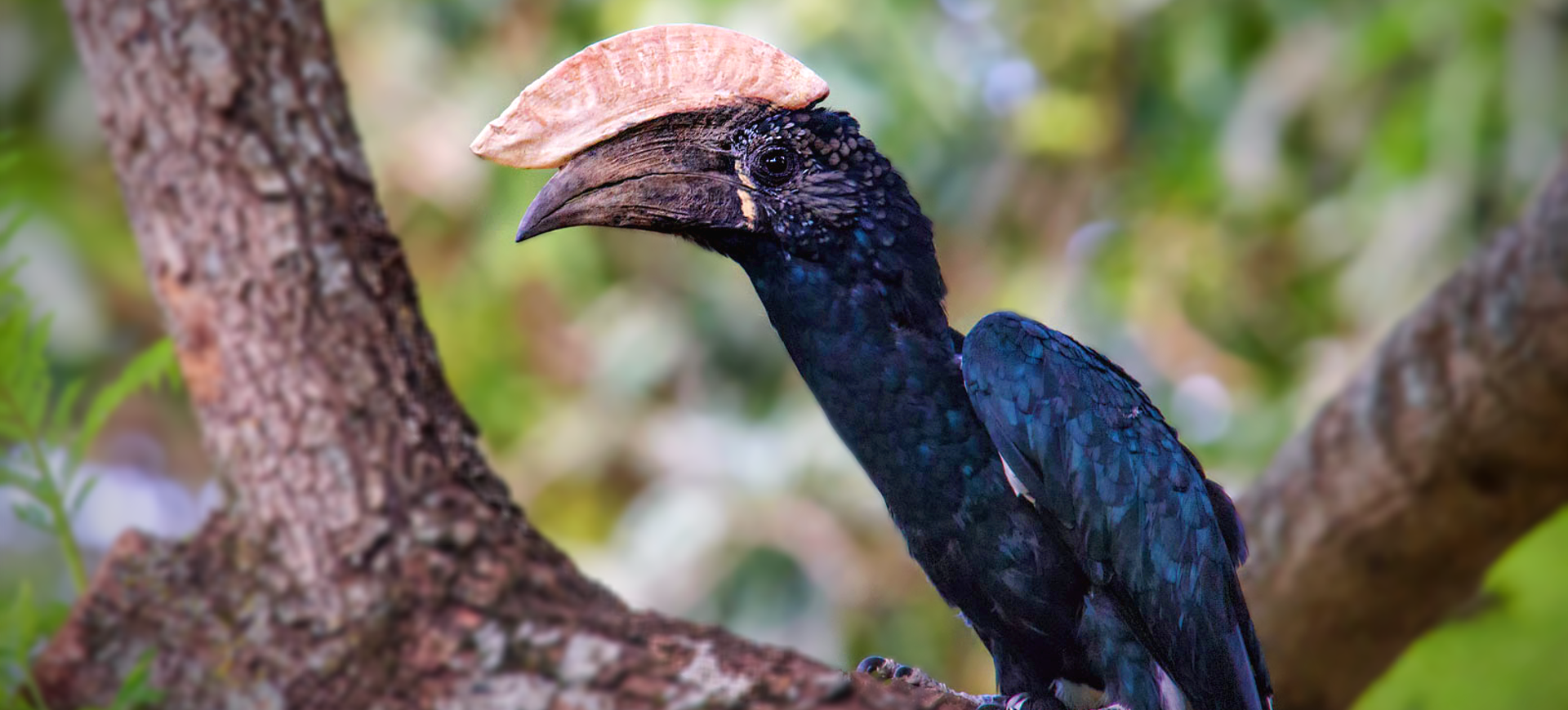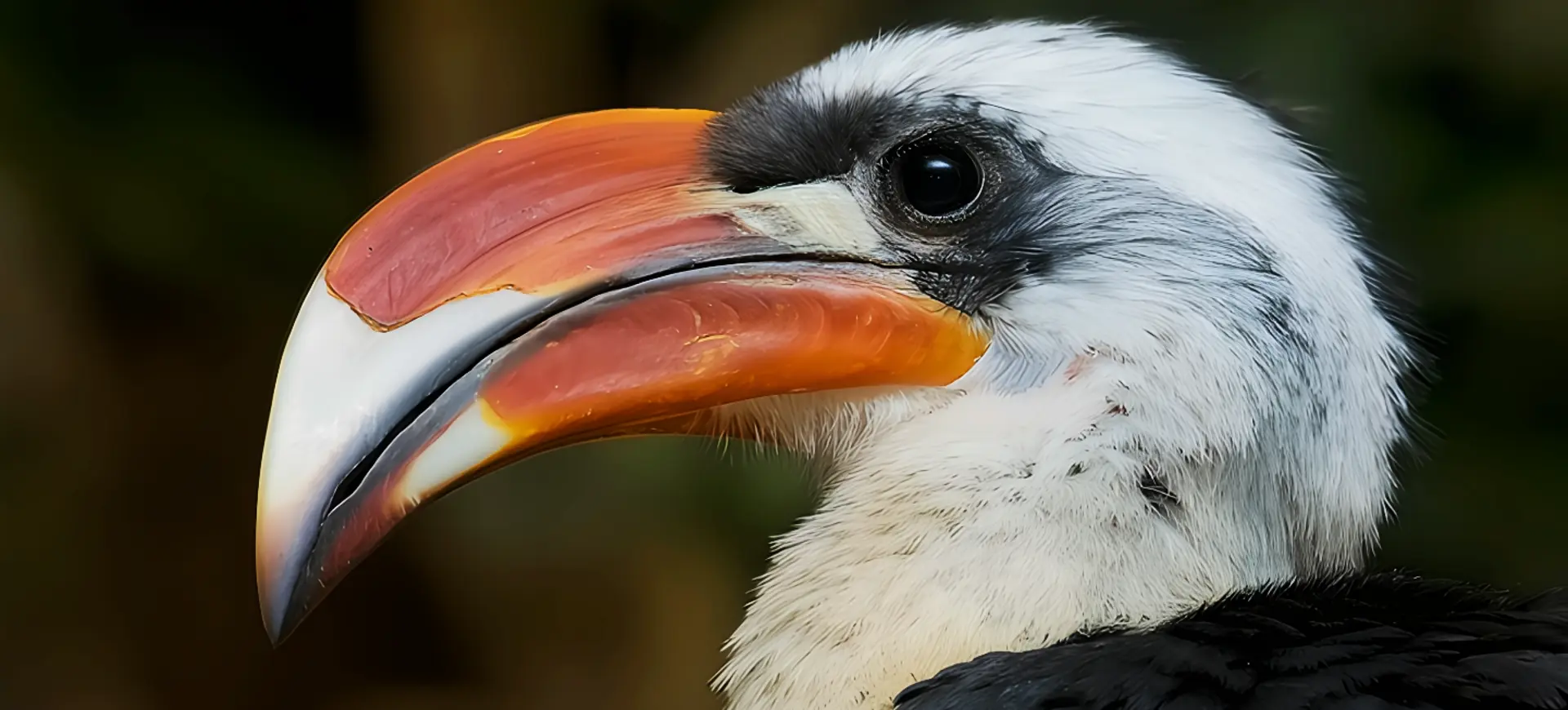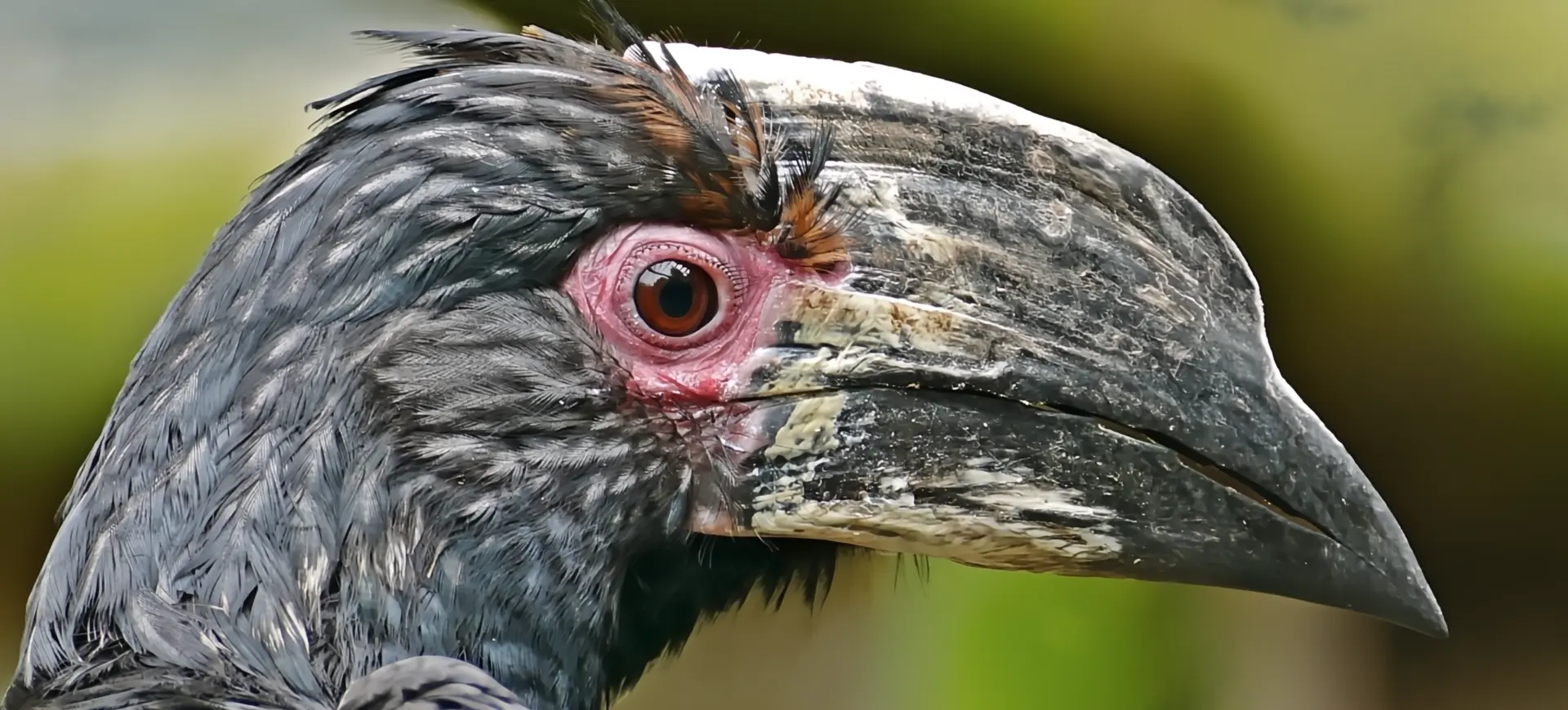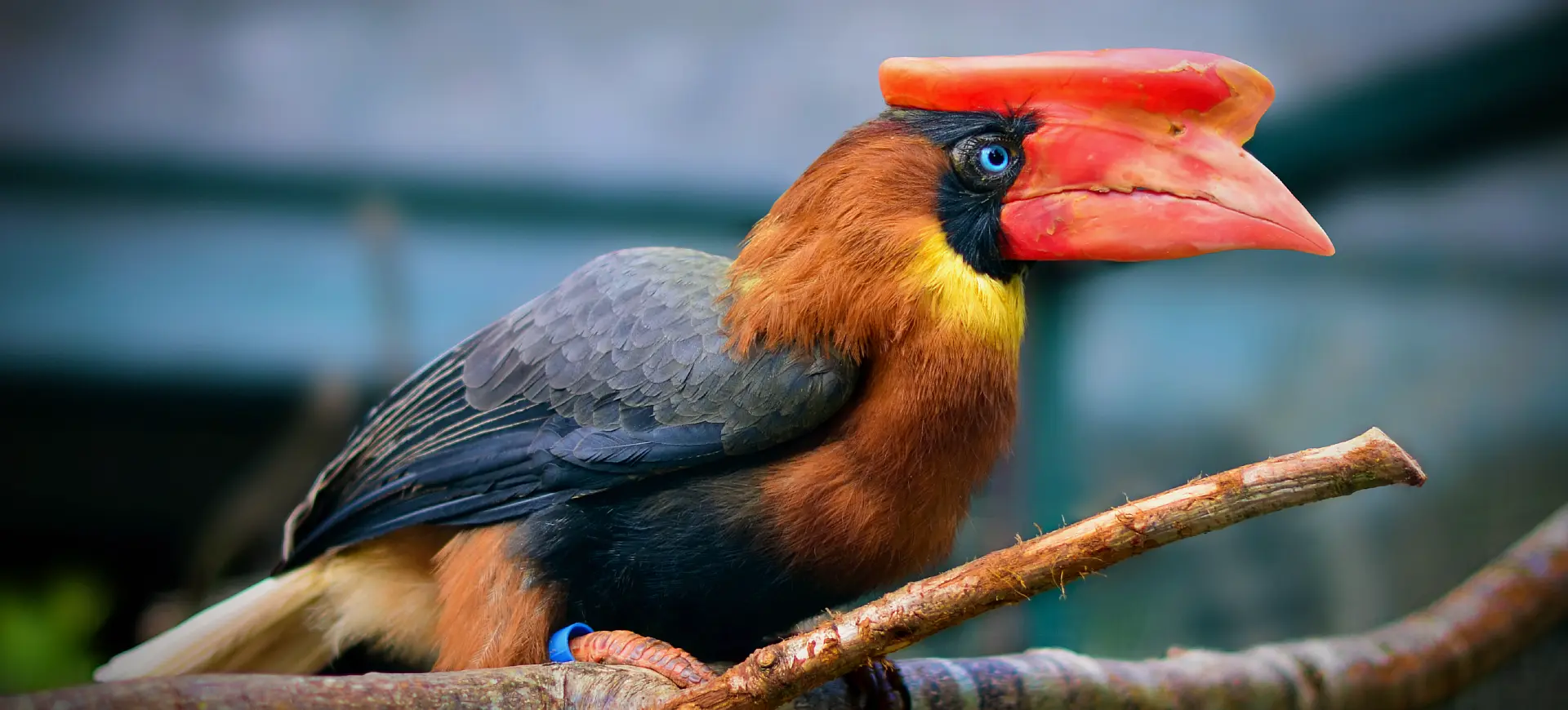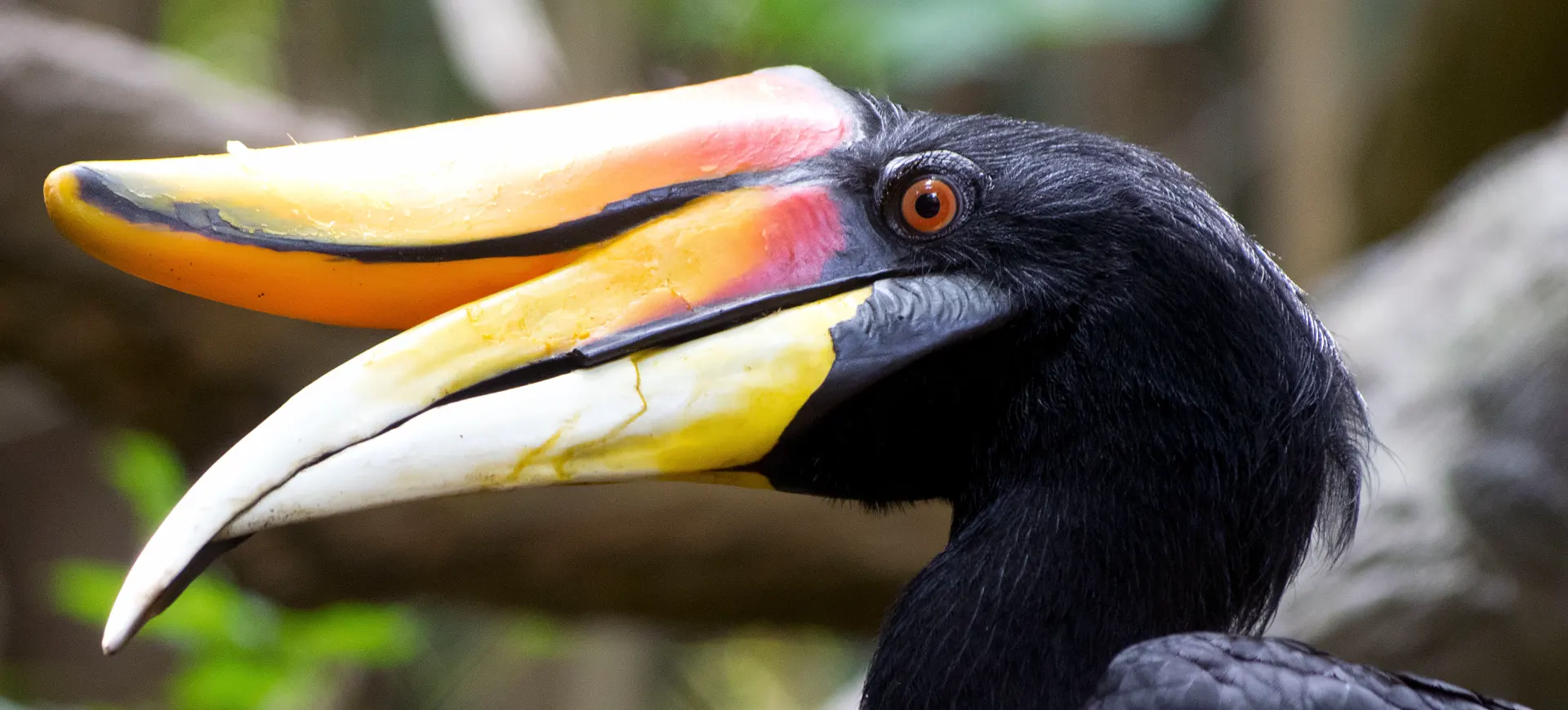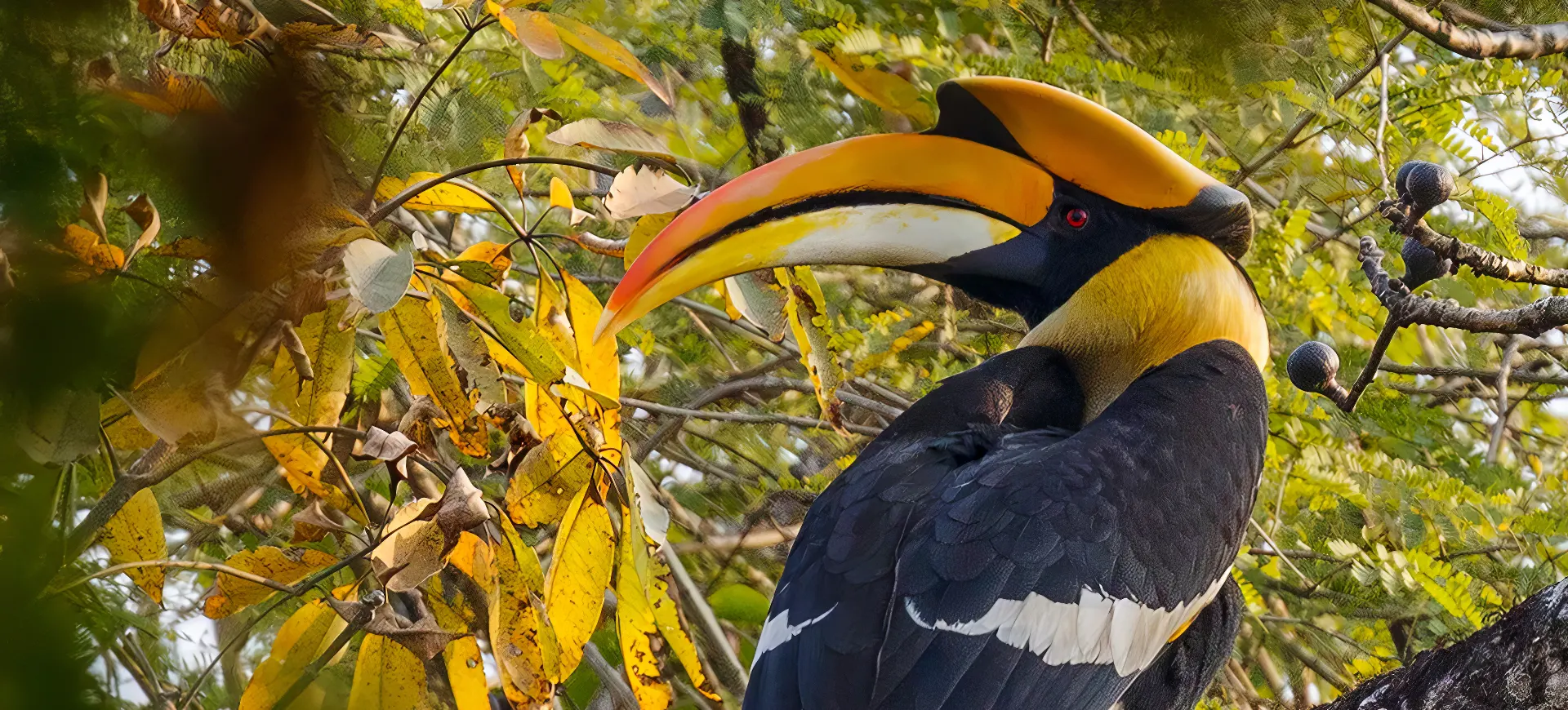Overview
The Knobbed Hornbill, known scientifically as Rhyticeros cassidix, is a striking bird indigenous to the Sulawesi region of Indonesia. It is easily recognizable by its large, bright yellow and orange casque atop its bill, making it one of the most visually distinctive hornbills. These birds play a crucial ecological role as seed dispersers, aiding in maintaining their forest habitats. Their vibrant plumage is primarily black with a white belly and legs, and their eyes are red, adding to their distinctive appearance.
The Knobbed Hornbill is a large bird, with males typically larger and more brightly colored than females. This sexual dimorphism is common in hornbill species. They are known for their loud, echoing calls that resonate through the rainforests they inhabit. These calls and their large size and vivid coloration make them easily detectable in their natural habitat.
Knobbed Hornbills are highly social and monogamous birds, often seen in pairs or small family groups. They exhibit remarkable nesting behaviors, where the female seals herself inside a tree cavity to lay and incubate eggs, relying entirely on the male for food. This unique behavior is a significant aspect of their life cycle and aids in protecting the eggs from predators. The conservation of their habitat is crucial, as it supports their survival and the intricate ecological balance of the rainforests they inhabit.
Taxonomy
Kingdom
Phylum
Class
Order
Family
Genus
Species
Type
Physical Description:
The Knobbed Hornbill is notable for its large size and the striking casque on top of its bill, which is larger in males. The males exhibit a bright orange and yellow casque, while females have a smaller, black casque. These birds have primarily glossy black plumage with a white belly and legs. The tail is long and white with a black band, adding to their distinctive appearance.
In addition to their casque, their eyes are a vivid red, creating a stark contrast against their dark feathers. The size of the casque and its vivid colors are thought to play a role in attracting mates and in species recognition. The bill is long and curved, aiding in their foraging behavior. Their robust and sturdy legs are well-adapted for gripping tree branches, an essential adaptation for a life predominantly in trees.

Lifespan: Wild: ~35 years || Captivity: ~35 years

Weight: Male: 5.5-6.6 lbs (2.5-3 kg) || Female: 4.4-5.5 lbs (2-2.5 kg)

Length: Male: 28-31 inches (70-80 cm) || Female: 24-28 inches (60-70 cm)

Wingspan: Male & Female: ~60 inches (152 cm)

Top Speed: Unknown
Characteristic:
Native Habitat:
The Knobbed Hornbill is native to the tropical rainforests of Sulawesi and neighboring islands in Indonesia. These forests provide the ideal habitat with abundant fruiting trees, especially figs, which are essential for their diet. They are typically found in primary and secondary forests near clearings and river edges. These rainforests’ dense canopy and high humidity offer the ideal conditions for their nesting and foraging behaviors.
These birds are adapted to life in the trees, utilizing the high canopy for feeding, nesting, and social interactions. They rarely descend to the ground, preferring the safety and resources available in the treetops. Their dependency on forest habitats makes them sensitive to deforestation and habitat loss. The preservation of their rainforest habitat is essential for their continued survival and the region’s ecological balance.
Climate Zones:
Biomes:
WWF Biomes:
Biogeographical Realms:
Continents:
Countries:
Diet:
Diet & Feeding Habits:
The Knobbed Hornbill is primarily frugivorous, feeding on a variety of fruits found in its rainforest habitat. Their diet primarily consists of figs, which are crucial for their nutritional needs and are abundant in their habitat. They also consume other types of fruit and are known to occasionally eat insects and small animals, particularly during the breeding season. Their foraging behavior significantly impacts seed dispersal in their ecosystem, aiding in forest regeneration.
These birds use their large bills to pluck fruit from trees and reach crevices. They have a unique feeding strategy: tossing food into the air and catching it in their bills before swallowing. In addition to foraging for themselves, male Knobbed Hornbills play a critical role in feeding their mates and offspring during the nesting period. The abundance of fruit in their habitat is crucial for their survival, making habitat conservation efforts vital.
Mating Behavior:
Mating Description:
Knobbed Hornbills are monogamous, forming long-term pair bonds. The courtship involves elaborate displays, including aerial chases and the exchange of food, which strengthens the pair’s bond. The nesting process is unique; the female seals herself inside a tree cavity to lay eggs, relying entirely on the male to provide food. This behavior protects the eggs and chicks from predators and strengthens the pair’s bond.
The female typically lays two eggs, which she incubates while sealed inside the nest. During this time, the male is responsible for nourishing his mate and the developing chicks. After the chicks hatch, the female breaks out of the nest, and both parents continue to feed the chicks until they are ready to fledge. This intensive parental care is crucial for the survival of the offspring in the dense rainforest environment.
Reproduction Season:
Birth Type:
Pregnancy Duration:
Female Name:
Male Name:
Baby Name:
Social Structure Description:
Knobbed Hornbills are social birds, often seen in pairs or small family groups. Their social interactions are characterized by mutual preening and food sharing, strengthening social bonds. During the breeding season, pairs become more territorial and less tolerant of other hornbills. However, outside of the breeding season, they can be seen in larger groups, especially in areas with abundant food sources.
The social structure of the Knobbed Hornbill is closely linked to their breeding behavior. The male’s role in feeding the female and chicks during the nesting period is critical to their social dynamics. These birds also engage in communal roosting, where several individuals gather in a single tree, providing safety in numbers. Their social behavior plays a key role in their survival, facilitating effective foraging and protecting the young.
Groups:
Conservation Status:
Population Trend:
The Knobbed Hornbill population in the wild is not precisely quantified, but it is known to be decreasing. The primary reasons for their population decline include habitat loss due to deforestation and hunting for meat and casques. These factors have led to a reduction in their numbers in certain parts of their range. Conservation efforts are crucial to reverse this trend and ensure the species’ survival.
The bird’s dependency on large tracts of rainforest for foraging and nesting makes them particularly vulnerable to habitat destruction. Conservation strategies focusing on habitat preservation and restoration are essential. Additionally, education and awareness programs in local communities can help reduce hunting pressures. International cooperation is also necessary to control illegal wildlife trade, threatening these birds.
Population Threats:
The primary threat to the Knobbed Hornbill is habitat loss due to extensive deforestation in Sulawesi and neighboring islands. Logging, agricultural expansion, and development projects are reducing the extent and quality of their rainforest habitat. This habitat loss directly impacts their food sources and nesting sites, which are crucial for survival and reproduction. Climate change is also a concern, as it can alter the fruiting patterns of trees, affecting their food availability.
Hunting is another significant threat to these hornbills. They are hunted for their meat and the distinctive casque on their bills, valued in some cultures for ornamental purposes. The illegal pet trade also poses a risk, although less significant than habitat loss and hunting. Effective law enforcement and community engagement are necessary to combat these threats.
Conservation Efforts:
Conservation efforts for the Knobbed Hornbill primarily focus on habitat protection and restoration. Establishing and effectively managing protected areas in Sulawesi is crucial to preserve their natural habitats. Reforestation projects can also help restore degraded areas and provide additional resources for these birds. Community-based conservation initiatives are being implemented to involve local populations in protecting these hornbills.
Education and awareness campaigns are essential to reduce hunting pressures and the demand for hornbill parts. Collaboration with local communities to develop sustainable livelihoods can reduce dependence on forest resources. International cooperation is needed to combat illegal wildlife trade. Research on the species’ ecology and behavior is vital to inform conservation strategies and monitor population trends. Efforts to understand the impact of climate change on their habitat and food sources are also important to ensure long-term conservation success.
Additional Resources:
Fun Facts
- The Knobbed Hornbill’s casque is not solid bone but a honeycomb-like structure that is surprisingly lightweight.
- They have a unique way of sealing the nest: the female uses her feces and food remnants to create a seal, leaving only a small slit for the male to pass food through.
- These hornbills can swallow fruit whole and later regurgitate the indigestible seeds, aiding forest regeneration.
- The echoing call of the Knobbed Hornbill can be heard up to half a mile away in the dense rainforest.
- Unlike many other bird species, the Knobbed Hornbill’s feathers lack the preen gland for oiling the feathers, relying on rain to keep their plumage clean.
- They have a long lifespan, living up to 35 years in the wild, which is relatively long for bird species.
- The Knobbed Hornbill is considered a symbol of fidelity in some cultures due to its monogamous nature.
- During the nesting period, the male may make up to 70 daily trips to feed the female and chicks.
- The vibrant color of the male’s casque is thought to be due to carotenoids in their fruit-based diet.
- These birds play a critical role in their ecosystem as keystone species due to their seed dispersal activities.





